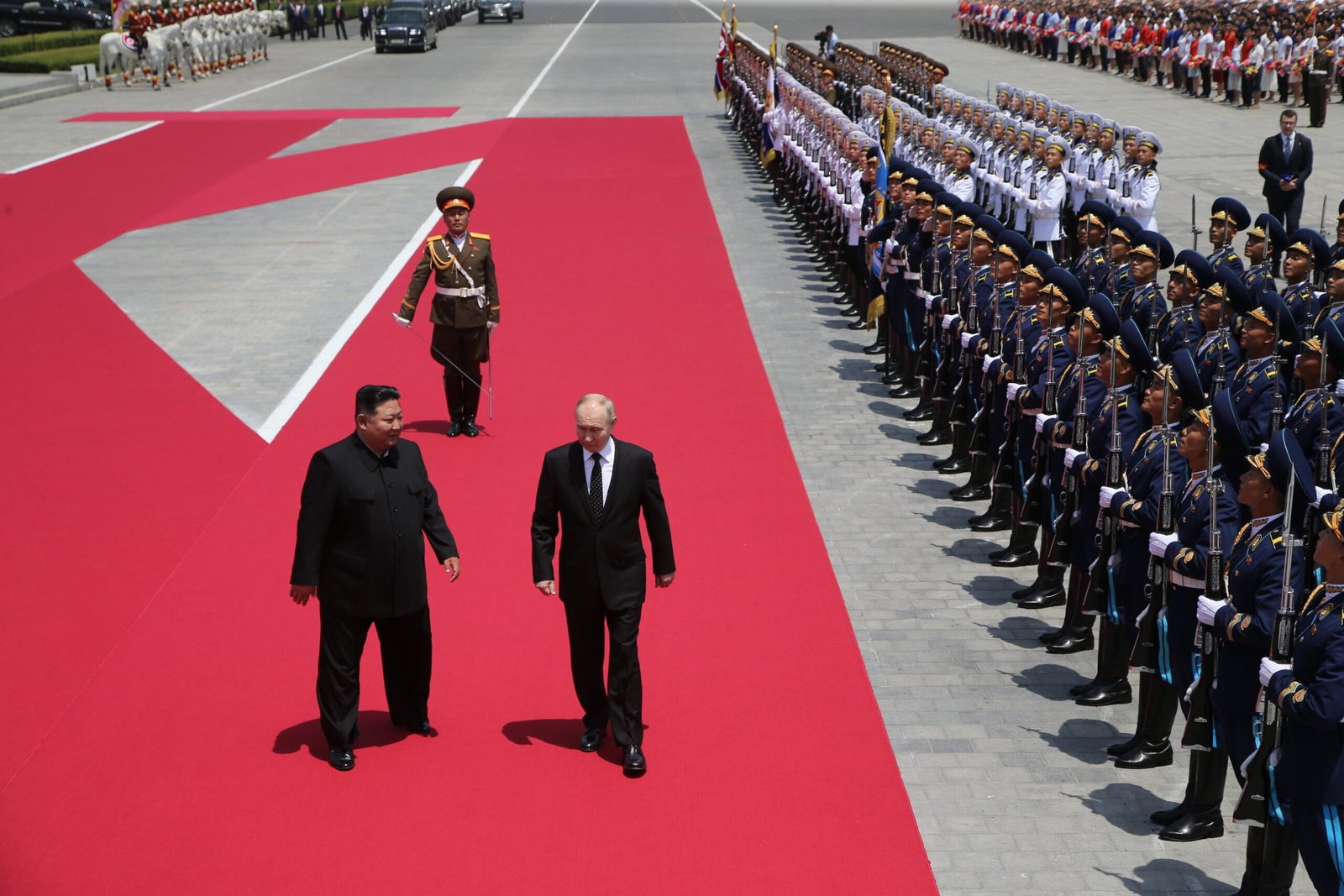
Russia’s strategy in executing its aggressive war against Ukraine, passing the 1,000-day mark last week, puts the country’s economy, society, and armed forces under enormous pressure that Moscow’s militaristic propaganda cannot quite cover.

Vladimir Putin (R) and Kim Jong Un before Russian-North Korean talks in June 2024 in Pyongyang, North Korea. Photo: Contributor/Getty Images
Relentless attacks, necessary for proving Russia’s control of the strategic initiative, produce casualties so heavy that recruitment based on outlandish payments cannot compensate for the number of losses (see EDM, August 7; Mediazona, November 22). Public support for the war cannot be measured with any accuracy, but opinion polls show a steady increase in preferences for immediate peace talks (Levada.ru, November 6; The Moscow Times, November 22). Escalation is the only way to alter the pattern of fast-progressing attrition.
In November, Russian President Vladimir Putin opted to take three demonstrative escalatory steps aimed at both undermining Ukraine’s will to resist and weakening Western resolve to confront Russian aggression.
Upgrading the nuclear doctrine
The first step was upgrading Russia’s nuclear doctrine, with Putin seeking to put the maximum possible spin on this declaratory measure. First, he delivered a series of heavy hints on the revisions, then announced some changes at a special session of the Security Council in September, and finally signed the decree with the full text on November 19 (Izvestiya, November 19).
Mainstream experts trumpeted the symbolic significance of lowering the threshold for nuclear weapons use, however, the revisions amounted merely to vague wording and had been debated previously at great length (RIAC, November 22). More assertive formulations had been suggested and expected, but Putin had to consider China’s reservations against resorting to nuclear brinkmanship. He did not dare to take a firmly negative stance against Beijing’s hostile position toward the first-use of nuclear weapons (Carnegie Politika, November 21).
North Korean troops
Putin’s second step was the deployment of some 12,000 North Korean troops into the zone of combat operations in Kursk oblast. Valerii Zaluzhny, former Commander-in-Chief of Ukrainian Armed Forces, described this as the escalation to a third World War (see EDM, October 30; RBC; Forbes.ua, November 21).
The Kremlin’s official position was neither denial nor confirmation, but the media was instructed to ignore this development, so only some elliptic references have been made by commentators and “patriotic” bloggers (TopWar.ru, November 10; Kommersant, November 21). There was hardly any space for doubt in Moscow that transforming the strategic partnership with Pyongyang to “brotherhood-in-arms” would invite a strong response from the Biden administration (Carnegie Politika, November 5). The long-delayed permission for Ukraine to use Army Tactical Missile Systems (ATACMS) to strike Russian territory was certainly anticipated in Moscow, and the revision of the nuclear doctrine was only a part of the prepared answer (Riddle, November 22).
Missile strikes
The Ukrainian strikes were delivered without delay, but neither the hit on an arsenal in Bryansk oblast nor the annihilation of a command center in Kursk oblast amounted to escalation due to similar strikes having already been made earlier with Ukrainian weapon systems (Republic.ru, November 22). Putin, nevertheless, found it opportune to make a third escalatory step — the strike on the Yuzhmash plant in Dnipro with a new intermediate-range ballistic missile called “Oreshnik” (see EDM; Nezavisimaya Gazeta, November 21). It was the first launch of this mobile missile, combining elements of various designs and carrying multiple warheads, unlike the Topol-M intercontinental ballistic missile or Iskander-M short-range ballistic missile (Meduza, November 22; The Moscow Times, November 23). Putin was visibly elated, announcing the success of this “combat test,” particularly as the Sarmat intercontinental ballistic missile test in September, which he announced as ready for deployment back in May 2018, resulted in an explosion in the silo (Kommersant, November 22).
The illusion of gaining escalation control may expire quickly as Ukrainian long-distance strikes continue, while Putin’s promise of more “tests” and the mass production of the Oreshnik is curtailed by the Votkinsk plant’s limited industrial capacity (Kommersant, November 23). He has no more “safe” options for escalation and will be compelled to assess the consequences of resuming nuclear testing or executing a non-strategic nuclear strike, as some audacious experts in Moscow continue to recommend (RIAC, November 21). Although the theme of nuclear war may be “normalized” in jingoist propaganda,
Putin is perfectly aware of the extreme risks, and public opinion remains deeply worried and resolutely opposed to propelling the so-called “special military operation” to the brink of nuclear catastrophe (The Moscow Times, November 22).
NATO response
Moscow is not particularly concerned about the upcoming North Atlantic Treaty Organization (NATO)-Ukraine Council meeting, which was called to discuss the joint response to the Oreshnik missile strike. Instead, the Kremlin is paying close attention to the reactions of two key leaders of the coalition, both undergoing political transitions: the United States and Germany (NV.ua, November 22). In the latter case, Chancellor Olaf Scholz’s words about “terrible escalation” are interpreted as a sign of paralyzing worries, potentially impacting the outcome of the forthcoming elections (RBC, November 22). The primary attention is undoubtedly focused on the changes in risk assessments of the United States, and Moscow experts venture opinions on US President Joe Biden’s decision to grant Ukraine permission for strikes as an attempt to limit the choices available for President-elect Donald Trump (see EDM, November 18; Rossiiskaya Gazeta, November 19). These speculations tend to ignore that the decision to allow strikes was announced after the meeting of the two leaders in the White House, as well as following Biden’s meeting with Chinese President Xi Jinping at the G20 summit in Brazil (Novaya Gazeta Europe, November 22).
The Trump administration
The Kremlin anticipates the Trump administration will attempt to bring its war against Ukraine to an end and is preparing positions for neutralizing US pressure for compromises and working to ensure that any concessions that might be granted come primarily from Kyiv.
These efforts, however, do not reflect the real effect of Putin’s reckless climb on the ladder of escalation. Any possible deal that presumes to secure moderate gains and restore stability is now undercut by Russia’s demonstrated desire to subjugate a defiant Ukraine and split the Western coalition.
A ceasefire that would depend upon the goodwill of the domination-desiring Russian autocrat involves severe security risks for Europe, as they would fail to deter his next aggressive move driven by the Kremlin’s illusions of superior military might.
Ukraine cannot hope to restore its territorial integrity by inflicting a crushing military defeat on Russia, but a sequence of successful defensive and offensive operations, empowered by sustained Western military support, could deny Putin the strategic initiative and disillusion him in his perceived escalation dominance.
Source link







